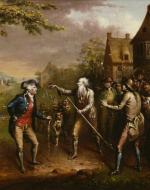Created by Mark Littke on Tue, 03/19/2024 - 05:30
Description:
In Quidor's painting of a significant plot point of Washington Irving's Rip Van Winkle, one can see among its colors and clusters of figures that the protagonist, Rip Van Winkle, is confidently and loudly attempting to explain to the town mob that he is the same man who was last seen a bit more youthful 20 years ago. In the background, a sign with a picture of George Washington painted somewhat sloppily over an image of King George is cleverly integrated; Rip seems to grapple with the confusion of his fellow townsfolk and boldly tries to reestablish his sense of belonging and way of life despite the massive political and social overhaul in his country during his two decade long slumber. Through this painting and the events surrounding it in Irving's story, the theme of death and rebirth in America arises. One can see that although old institutions and major powers of the world can change, dissipitate, and die in a moment, acceptance of the new and moving on with the common motions of life is the rebirth in the aged soul. What is interesting in Quidor's painting is when Rip is confronted by the town mob, he gestures forcefully at his son as an act to regain his sense of belonging in a now unfamiliar world ("Rip Van Winkle"). The painted Rip is more concerned about reconnecting with his son and belonging back to the town in his duty-avoiding ways than looking back and pointing to the sign of George Washington representing the great revolution. This is where one sees the irony in this theme of death and rebirth. The citizens of the story believe they have created a new world, but once Rip awakens in ignorance of their republican ways after 20 years of slumber, they experience a disconnect with him (Ferguson). This commotion is easily noticed in a couple particular lines of text in Irving's story: "'Alas! gentlemen,' cried Rip, somewhat dismayed, 'I am a poor quiet man, a native of the place, and a loyal subject of the king, God bless him!' Here a general shout burst from the by-standers—'A tory! a tory! a spy! a refugee! hustle him! away with him'" (Irving). Much like a young child growing up for eighteen years or a blissfully ignorant, common person, the Rip in the story and Quidor's painting represent the reality of a rebirthed society: great political and social change along with a renewed sense of community is rebirthed from the death of the old society, but many in that rebirth remain the same and seek the same things.
Further evidence of this humorously ironic theme is found in Irving's work itself: " His dress was of the antique Dutch fashion—a cloth jerkin strapped round the waist—several pair of breeches, the outer one of ample volume, decorated with rows of buttons down the sides, and bunches at the knees. He bore on his shoulder a stout keg, that seemed full of liquor, and made signs for Rip to approach and assist him with the load. Though rather shy and distrustful of this new acquaintance, Rip complied with his usual alacrity" (Irving). Despite the fact these mysterious Dutch gentlemen who have appeared to Rip are Dutch sailors from decades ago, Rip still accompanies them, accepts there help, and celebrates a responsibility-free evening with them before his impossibly deep slumber. A great deal of wars and power sieges have occured from the time of the Dutch in America to the British to the liberated Americans, yet everyone still seeks pleasure and order throughout all times as Quidor and Irving have illustrated.
Works Cited
https://en.wikipedia.org/wiki/Rip_Van_Winkle#/media/File:Depiction_of_Ri...(1829).jpg
Irving, Washington. “Rip Van Winkle.” Cove Studio, studio.covecollective.org/anthologies/eng-235-survey-of-american-literature-sp24/documents/rip-van-winkle. Accessed 19 Mar. 2024.
“Rip Van Winkle.” The Art Institute of Chicago, Arts of the Americas, 1 Jan. 1970, www.artic.edu/artworks/97873/rip-van-winkle.
Copyright:
Associated Place(s)
Part of Group:
Featured in Exhibit:
Artist:
- John Quidor


